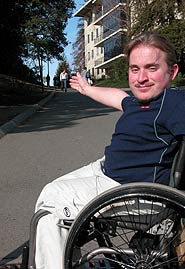Berkeleyan
A win-win for campus, disabled students
Class-action suit outcome an ‘outstanding opportunity’ to improve accessibility
![]()
| 19 January 2005
 “Heart Attack Hill” is what Peter O’Connell and other Berkeley students in wheelchairs call the more-than-15-degree grade from Memorial Glade to North Gate. One of the campus’s first projects under a new agreement will be to create a switchback path, navigable by wheelchair users, on one side of the grade. (Cathy Cockrell photo) |
The multiyear undertaking will include wide-ranging physical changes, improved on-campus transportation options, and a new procedure for students to get quick resolution to access problems, among other actions. Some of the improvements are already underway.
Berkeley has been a leader in higher education in providing innovative and progressive accommodations to its students with disabilities — though the campus’s terrain and the age of many of its buildings have created difficult challenges in addressing mobility needs.
“Sitting on the side of a giant hill is problematic,” says Berkeley junior Peter O’Connell, an access coordinator for the campus’s Disabled Students’ Program. “It’s just plain hard to get around for everybody, but for disabled students there are unique challenges.” He cites, as an example, the steep incline from Memorial Glade to North Gate (which he and others like to call “Heart Attack Hill”), along with mobility problems he’s encountered in some of the campus’s older buildings.
In light of these and other accessibility issues, the proposed agreement is “an outstanding opportunity to take a long-term, comprehensive approach to upgrading physical access,” says Sarah Hawthorne, assistant provost for equity standards and compliance. “This agreement underscores Berkeley’s longstanding commitment to ensure that all students benefit fully from their experience here.”
The agreement settles a class-action lawsuit, Gustafson v. Regents of the University of California. The named plaintiff in the case, Kaaryn Gustafson, was a doctoral and law student at Berkeley when the case was originally filed in federal court in 1997.
 |
“The cooperative nature of the process has been a great success in many ways,” said Jeffrey Blair, the UC Office of the General Counsel attorney who handled the matter. “The university was able to incorporate ideas and recommendations from students and disability advocates from the community in a non-adversarial, cooperative manner. The university conservatively saved several million dollars in attorneys’ fees and more in litigation expenses and has forged a more collegial relationship with the disability community that will benefit both sides for years to come.”
Those addressed in the class-action suit are Berkeley students with mobility and visual disabilities. Currently, there are about 100 such students enrolled on campus. A final approval hearing is set for March 23 in federal district court in San Francisco.
The settlement addresses two aspects of campus access: mobility involving the physical premises, such as paths of travel between buildings and barriers that may limit access inside buildings, and program and activities access, such as the ability to participate in class trips and attend cultural and athletic events.
Hawthorne, who will provide campuswide leadership and work with the campus’s Disabled Students Program, said that while the suit was focused on students, many of the improvements such as signage, paths through campus, and building evacuation and safety practices will benefit campus staff, visitors, and others for whom mobility and visibility access are concerns.
Implementation of the settlement is already underway and is expected to span several years, as the campus seeks to make improvements in the most cost-effective way, such as folding in access improvements as older buildings are modernized.
A 35-point summary of the settlement is available online at equity.chance.berkeley.edu/Gustafson_Notice.pdf.

